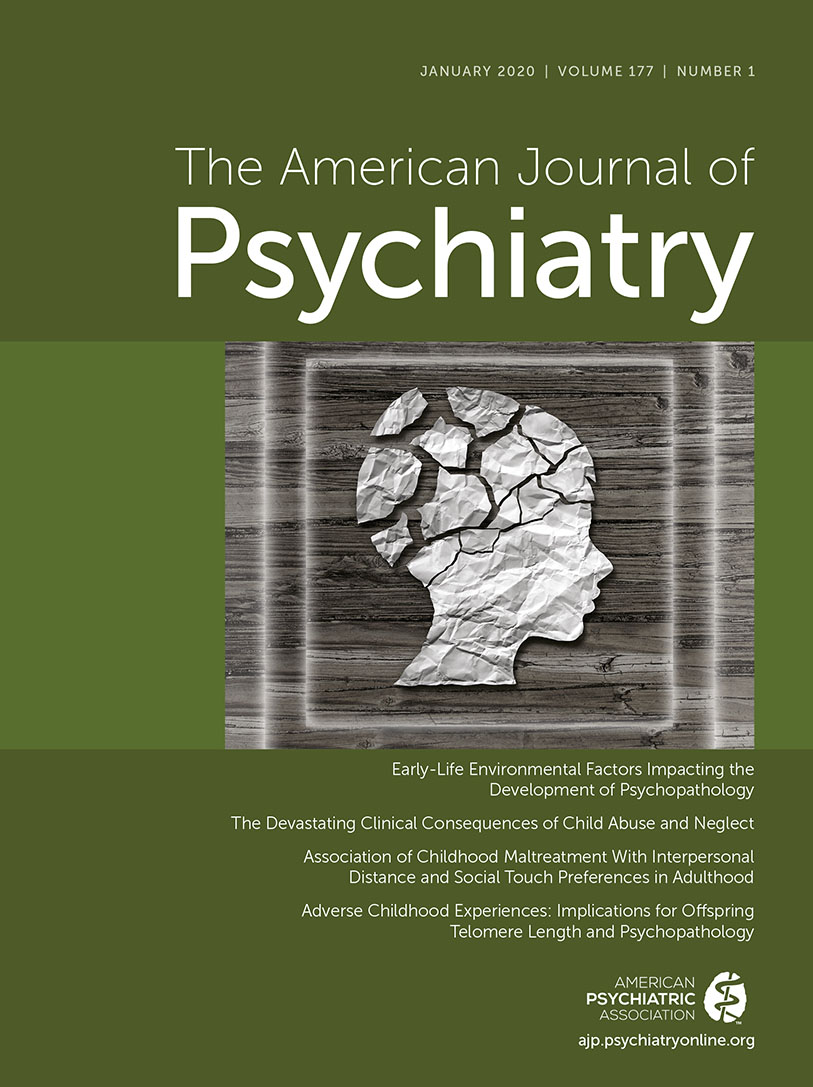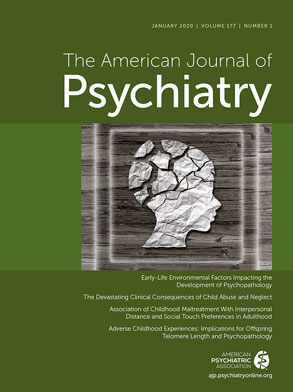Our conceptualization of the factors that increase the risk to develop psychiatric illness is broadly focused on gene-by-environment interactions, as the illnesses that we deal with are both heritable and markedly influenced by experiences and other environmental factors. While heritability estimates range from 20%−45% for anxiety and depressive disorders to 75% and greater for bipolar disorder and schizophrenia (
1), recent research has underscored the genetic complexity underlying the heritability of these disorders. Although some rare genetic variants with large effects have been identified, in general, the heritability of psychiatric illnesses involves a multitude of interacting common gene variations that each contribute a very small amount to the risk (
2). Nongenetic factors clearly play an important role and via epigenetic mechanisms (e.g., DNA methylation and histone modification of chromatin) affect gene function by modulating gene expression (
3). Most of the illnesses that we deal with in psychiatry have neurodevelopmental origins, which underscores the importance of focusing on early life as an age to understand how nonheritable factors interact with the genome to confer vulnerability. During early life, environmental influences have the potential to affect the rapid brain development that is occurring and that underlies the acquisition of behavioral, emotional, and cognitive abilities (
4).
When considering the nonheritable factors that are critical determinants, we know from extensive research that early-life stress, adversity, and especially trauma present prominent risks for the later development of psychopathology. Not only is it critical to understand the type and the severity of the adversity that an individual is exposed to, it is also important to understand how these significant environmental exposures interact with different neurodevelopmental stages. During the prenatal period, the developing fetus interfaces with the outside world via the pregnant mother. Depending on the specific circumstances, the fetus might be exposed to the consequences of prenatal depression or other stressful maternal experiences, as well as infections or drug exposure. We also must remember that there is frequently a continuity across the prenatal and postnatal periods in relation to stressors and environmental exposures, whereas with some environmental exposures, this may not be the case. Sadly, early-life physical abuse, sexual abuse, and neglect are all too common, and extensive research, as well as our own clinical observations, document the devastating consequences and profound effects on mental and general medical health that result from childhood maltreatment (
5). New molecular evidence supports the notion that the first 5 years of life may be particularly important as a period of vulnerability. For example, a study examining the developmental time course of DNA methylation has demonstrated that the first 5 years of life are the period during which neurons exhibit the greatest epigenetic plasticity, suggesting that this could be a mechanism by which environmental events are especially influential when occurring early in life (
6).
This issue of the
Journal, focused on early-life environmental factors that are associated with the development and treatment of psychopathology, provides new insights into the biological, social, and health-related outcomes resulting from adversity and trauma exposure. The review by Lippard and Nemeroff (
7) is the centerpiece of the issue as it comprehensively addresses the relation between childhood maltreatment and the development and treatment of mood disorders. While maltreatment is a broad risk factor for psychopathology, this review presents an in-depth examination of abuse and neglect in relation to mood disorders, discussing sensitive periods, the consequences of different types of abuse, mechanisms conveying risk to develop mood disorders, and poor treatment outcomes.
Maier and colleagues (
8) shed light on basic factors relevant to social dysfunction, interpersonal distance, and responsiveness to touch in adults with a history of childhood abuse. In addition to behavioral testing, structural and functional MRI was performed to assess the neural correlates of social touch in relation to varying degrees of maltreatment. Overall, the findings suggest alterations in neural responsivity to sensory stimulation with both fast and slow touch. Of particular interest was the finding that severe maltreatment was associated with decreased hippocampal responsivity to slow touch, which tends to be associated with the emotion-relevant, comforting aspects of touch. Dr. Martin Teicher from McLean Hospital and Harvard Medical School, an expert in the relation between childhood trauma and psychopathology, provides an editorial that further discusses critical periods during development, the importance of understanding trauma-type selective effects, and the potential adaptive nature of the neural and behavioral changes that result from early trauma (
9).
The study by Esteves et al. (
10) is particularly thought provoking as it links adversity occurring during the mother’s childhood to her infant’s telomere biology. In their article, the authors present data that speak to the intergenerational transfer of the consequences of trauma by studying the relation between a mother’s history of childhood adverse experiences with telomere shortening and the infant’s mental health. Telomeres, located at the end of chromosomes, function to protect against chromosomal damage, and their physical length has been linked to the aging process as well as general medical and mental health (
11). Esteves et al. report data demonstrating an association between high levels of adversity in mothers when they were children with increased externalizing problems and shorter telomere length in their offspring. Using statistical methods, the authors suggest that there is an interaction between maternal childhood adversity and telomere length on the outcome of externalizing problems. Dr. Elissa Epel from the University of California, San Francisco, a leader in understanding psychological stress and telomere biology, provides an editorial that discusses these findings in the context of other work in the field (
12). In her piece, she highlights the potential importance of the reported intergenerational findings and discusses the multiple mechanisms that could underlie the linkage between maternal early-life experience and offspring telomere length.
Michopoulos and colleagues (
13) examine immune-related predictors for developing posttraumatic stress disorder (PTSD) in acutely traumatized adults in a unique study that was performed in the emergency department at Atlanta’s Grady Memorial Hospital. In this study, the researchers used a prospective longitudinal design to explore the relation between immune factors that are assessed in close proximity to the trauma with the long-term consequences of the trauma. The authors found that decreased levels of the proinflammatory markers tumor necrosis factor α and interferon-γ were predictive of a chronic PTSD course. This result was somewhat surprising as much research has suggested that increased inflammatory markers are associated with PTSD. Nevertheless, the experimental design used here, along with the findings, highlight the possibility that such measures collected immediately after a traumatic event may provide information regarding individuals at greatest risk of developing disabling symptoms and who therefore may benefit from early interventions. Dr. Christine Heim, an expert in stress and trauma, professor at the Institute of Medical Psychology of the Charité university hospital in Berlin, and professor of biobehavioral health at Penn State University, offers insights into the importance of this finding in her editorial (
14). She speculates on the meaning of the finding that the development of chronic PTSD is associated with a reduction in proinflammatory markers and relates this to other work, addressing relations among trauma, pituitary-adrenal alterations, and PTSD.
Moving to prenatal influences that increase the risk for developing psychiatric illness, Lee and colleagues (
15) present data linking bacterial infections during pregnancy to psychotic disorders in offspring. Although it is not news that prenatal infections, especially viral infections such as influenza, are associated with schizophrenia (reviewed in reference
16), this study examined from more than 15,000 pregnancies the influences of prenatal maternal bacterial infections. Offspring were followed into adulthood to between ages 32 and 39, and findings demonstrated that localized maternal bacterial infections increased the odds of developing a psychotic disorder by 1.6 times, whereas multisystemic infections increased the odds by 2.9 times. Interestingly, these effects appeared to be sex specific, with the effect predominantly occurring in exposed male offspring. In his editorial, Dr. Ken Kendler, a renowned expert in the epidemiology and genetics of psychiatric disorders from Virginia Commonwealth University, discusses issues related to the interpretation of causality as well as the potential importance of these findings for prevention (
17).
Finally, Fornaro et al. (
18) alert us to questions regarding the effects of the medications we use for the treatment of maternal psychiatric illness on the developing neonate. To address safety issues related to the use of lithium during pregnancy, the authors performed a meta-analysis and found that the overall risk associated with lithium treatment was present but low. The odds ratio for lithium to be associated with any congenital abnormality was 1.81, and for cardiac anomalies it was 1.86. Mothers with lower lithium levels (less than 0.64 mEq/L) did not appear to have an increased risk for producing offspring with cardiac malformations. Importantly, this analysis confirmed that lithium treatment was effective in preventing the postpartum relapse of bipolar disorder. This article is a valuable in-depth review and analysis, and the authors conclude by providing important and practical recommendations for the use of lithium treatment during pregnancy.
In conclusion, this issue of the Journal provides new and important insights relating to the treatment of and the risk for developing psychopathology. Ongoing molecular and neural circuit–based work has the potential to more specifically elucidate the mechanisms by which environmental events affect the rapidly developing young brain in ways that increase vulnerability. At the same time, the insights presented in this issue regarding early-life environmental factors that influence neonatal development have the potential to inform intervention approaches that would increase resilience by buffering the heritable genetic factors that confer disease risk.

